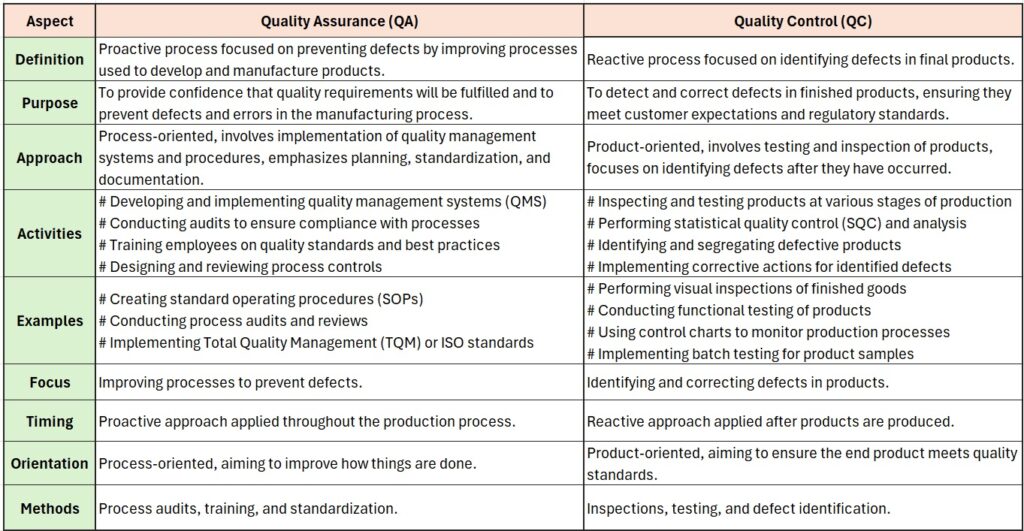Quality Assurance (QA) and Quality Control (QC) are both crucial aspects of ensuring product quality in manufacturing and other industries, but they focus on different areas of the quality management process. Here’s a detailed comparison:
Quality Assurance (QA)
Definition:
- QA is a proactive process that focuses on preventing defects by improving the processes used to develop and manufacture products. It aims to ensure that the product is made right the first time.
Purpose:
- To provide confidence that quality requirements will be fulfilled.
- To prevent defects and errors in the manufacturing process.
Approach:
- Process-oriented.
- Involves the implementation of quality management systems and procedures.
- Emphasizes planning, standardization, and documentation.
Activities:
- Developing and implementing quality management systems (QMS).
- Conducting audits to ensure compliance with processes.
- Training employees on quality standards and best practices.
- Designing and reviewing process controls.
Examples:
- Creating standard operating procedures (SOPs).
- Conducting process audits and reviews.
- Implementing Total Quality Management (TQM) or ISO standards.
Quality Control (QC)
Definition:
- QC is a reactive process that focuses on identifying defects in the final products. It aims to ensure that the outputs meet the specified quality requirements.
Purpose:
- To detect and correct defects in finished products.
- To ensure that the product meets customer expectations and regulatory standards.
Approach:
- Product-oriented.
- Involves testing and inspection of products.
- Focuses on identifying defects after they have occurred.
Activities:
- Inspecting and testing products at various stages of production.
- Performing statistical quality control (SQC) and analysis.
- Identifying and segregating defective products.
- Implementing corrective actions for identified defects.
Examples:
- Performing visual inspections of finished goods.
- Conducting functional testing of products.
- Using control charts to monitor production processes.
- Implementing batch testing for product samples.
Key Differences
- Focus:
- QA focuses on improving processes to prevent defects.
- QC focuses on identifying and correcting defects in products.
- Timing:
- QA is a proactive approach applied throughout the production process.
- QC is a reactive approach applied after products are produced.
- Orientation:
- QA is process-oriented, aiming to improve how things are done.
- QC is product-oriented, aiming to ensure the end product meets quality standards.
- Methods:
- QA involves process audits, training, and standardization.
- QC involves inspections, testing, and defect identification.
Conclusion
Both QA and QC are essential for ensuring product quality, but they serve different purposes within the quality management system. QA aims to prevent defects by improving processes, while QC aims to identify and correct defects in finished products. Together, they provide a comprehensive approach to quality management, ensuring products meet both regulatory standards and customer expectations.
Click below for more article
- X-bar & R vs. I-MR Charts in SPC:

- What is Camber Defect in Steel Manufacturing?

- Top 15 MNCs Every Mechanical Engineer Dreams of Joining in 2025

- How to Digitize and Automate the CAPA Process

- Top 10 Essential Tools Every Mechanical Engineer Should Know

- What is GD&T (Geometric Dimensioning & Tolerancing) ?

- Principles of IATF 16949: A Guide to Quality Management

- The Evolution of IATF 16949: The Automotive Quality Standard

- Top Interview Questions Related to SPC ,Cp and Cpk

- Difference Between Purchase and Procurement

- Master Your Job Interview: Top 70 Common Interview Questions and Answers

- What Is Standard Deviation ?




